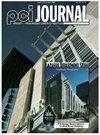Comparison of the design of prestressed concrete hollow-core floor units with Eurocode 2 and ACI 318
IF 0.9
4区 工程技术
Q4 CONSTRUCTION & BUILDING TECHNOLOGY
引用次数: 0
Abstract
A typical 1200 mm (48 in.) wide × 200 mm (8 in.) deep prestressed concrete hollow-core unit is analyzed and designed in order to make a comparison between Eurocode 2 and ACI 318-08. This includes calculations for serviceability limit state of stress and moment of resistance, ultimate moment of resistance, ultimate shear capacities, flexural stiffness (that is, for deflection), and cover to pretensioning tendons for conditions of environmental exposure and fire resistance. Concrete cylinder strength is 40 MPa (5.8 ksi), and concrete cube strength is 50 MPa (7.3 ksi). The hollow-core unit is pretensioned using seven-wire helical strands. Worked examples are presented in parallel formation according to Eurocode 2 and ACI 318. For uniformly distributed loads, the design criterion between the service moment to service moment of resistance (Ms/Msr for EC2 and Ms/Msn for ACI 318) and the ultimate design bending moment to ultimate moment of resistance (MEd/MRd for EC2 and Mu/φMn for ACI 318) is well balanced for this example. Usually the service moment is critical unless the amount of prestress is small. For EC2-1-1, flexurally uncracked shear capacity VRd,c is only limiting when the span-to-depth ratio in this example is less than about 35. For ACI 318, flexurally cracked shear capacity φVci is limiting when span-to-depth ratio is 42, showing that shear cracked in flexure will often be the governing criterion.符合欧洲规范2和aci318的预应力混凝土空心核心楼盖设计比较
分析和设计了一个典型的1200mm(48英寸)宽× 200mm(8英寸)深的预应力混凝土空心核心单元,以便与欧洲规范2和ACI 318-08进行比较。这包括可用性极限应力状态和阻力矩的计算,极限阻力矩,极限剪切能力,弯曲刚度(即挠度),以及环境暴露和耐火性条件下预应力筋的覆盖。混凝土柱体强度为40mpa (5.8 ksi),混凝土立方体强度为50mpa (7.3 ksi)。空心核心单元使用七线螺旋股进行预紧。根据欧洲规范2和aci318,以并行形式给出了工作实例。对于均布荷载,EC2的工作弯矩与工作弯矩之间的设计准则(Ms/Msr, ACI 318的Ms/Msn)和极限设计弯矩与极限阻力弯矩之间的设计准则(EC2的MEd/MRd, ACI 318的Mu/φMn)在本例中得到了很好的平衡。通常使用力矩是临界的,除非预应力量很小。对于EC2-1-1,在本例中,仅当跨深比小于35时,不开裂抗剪能力VRd,c才是极限。对于aci318,当跨深比为42时,受弯开裂抗剪能力φVci达到极限,表明受弯开裂往往是控制准则。
本文章由计算机程序翻译,如有差异,请以英文原文为准。
求助全文
约1分钟内获得全文
求助全文

 求助内容:
求助内容: 应助结果提醒方式:
应助结果提醒方式:


